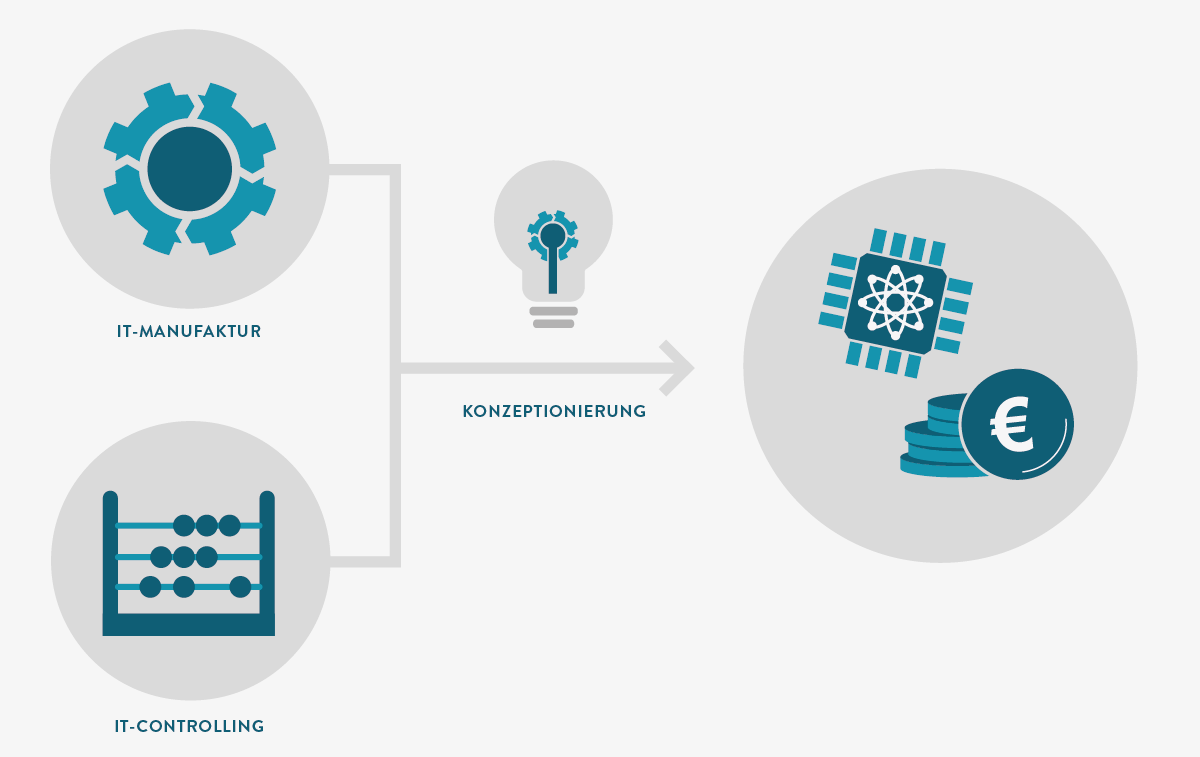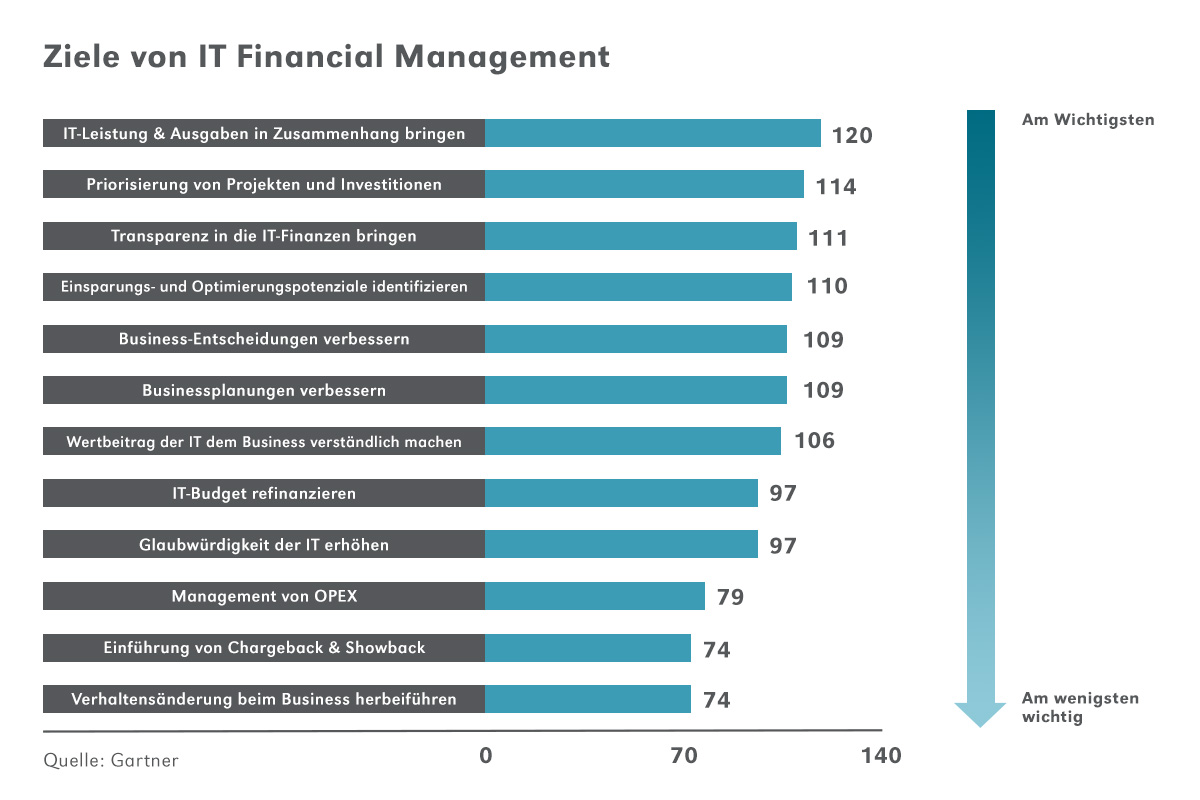The polymath Galileo Galilei once said that mathematics is the alphabet with the help of which God described the universe. So numbers are important. Galileo and modern IT agree on that. Just like Galileo, IT saw early on that numbers can be more than a mere sequence of digits. They condense facts and offer a basis for decision-making as key figures – and decisions must be made quickly and well-founded in the digital age. IT Financial Management (ITFM) supports/ensures transparency in the company’s own IT jungle and thus provides important data for strategic budget decisions.
The reasons why IT budgets should be planned much smarter today lie in the generally changing IT market and the pandemic in particular. Cloud, SaaS, apps – software beats hardware. In the future, the majority of all IT services will be provided as a service. So the question is: what value can the data produced by IT bring to the company? Simply asking yourself this question creates a culture of thinking beyond pure savings. Performance and value come first.
Budgets are not costs per se, but primarily resources to achieve goals. To achieve these goals, companies are looking for ways to use budgets optimally. The answer is provided by “IT Financial Management” (ITFM) (Gartner) or “Technology Business Management” (TBM) (Forrester).
What is IT Financial Management?
ITFM and TBM – both terms mean the same thing: one uses the tried and tested financial management instruments of the CFO and controlling – but transfers them to the specific requirements of IT. The process goals include looking at the IT organisation and IT services from a financial perspective and providing a basis for decision-making based on this. In this way, IT budgets can not only be planned more intelligently, but also monitored.
 What is IT Financial Management? Consequently, this means saying goodbye to the “eh da cost model” that only needs to be optimised. In budget planning according to ITFM aspects, IT is no longer a pure cost factor, but a resource for achieving goals.
What is IT Financial Management? Consequently, this means saying goodbye to the “eh da cost model” that only needs to be optimised. In budget planning according to ITFM aspects, IT is no longer a pure cost factor, but a resource for achieving goals.
Every euro budgeted in future IT budgets will have to prove itself in the future and will be in competition with each other. ITFM enables companies to carry out KPI-driven high-level management of IT from a financial point of view instead of simply saving money. As a result, companies can see which part of their IT should be renewed, sold or expanded in order to digitise further.
IT Financial Management is gaining in importance
ITFM is very progressive, but still largely unknown in Germany. Considering the general level of digitalisation in the German economy, this is not surprising. However, the pandemic showed how quickly the method had to be put into practice by companies. Corona forced many companies to reform their working methods within a short period of time: Remote work, trust-based working hours and flexible staff scheduling still dominate many companies and ensure that even the most conservative companies open up to these topics. The last barriers to moving at least parts of IT into the cloud are falling. An important step in order to continue to be able to act as a company under these new conditions.
When the pandemic began, IT departments initially focused on “system critical” tasks. The subsequent budget cuts put pressure on them to look at IT more from a business perspective. Performance, cost and security aspects came into focus in the evaluation.
 Maintaining transparency and an overview of all IT resources, services and IT costs became an elementary duty – and at the same time a challenge. Those who still shy away from this challenge are not only groping in the dark, but also heading in the wrong direction. Because this will not make the company more efficient, but IT will become more and more expensive in the future.
Maintaining transparency and an overview of all IT resources, services and IT costs became an elementary duty – and at the same time a challenge. Those who still shy away from this challenge are not only groping in the dark, but also heading in the wrong direction. Because this will not make the company more efficient, but IT will become more and more expensive in the future.
Transparency provides a basis for decision-making
Providing transparency means monitoring IT services and performance. IT resources must be available for business services at the right time, in the right quantity and at the best possible cost. However, in-house resources are not infinitely scalable. In addition, changes tend to increase pressure on the budget rather than relieve it. These cost drivers must be permanently controlled and managed, regardless of the procurement method. Long-term commitments to specific, rigid technologies, for example, contradict resilience requirements.
Only very few companies could tell off the cuff which software subscriptions for Application as a Service (AaaS) or which provision of infrastructure as IaaS or Platform as a Service (PaaS) were still current, what they cost and what they bring. Barely any billing and remuneration models were recorded in a standardised way or even presented on a daily basis. Such a process would have made services and providers measurable and thus comparable and thus provided important bases for decision-making and planning in the crisis.
ITFM – The right presentation counts
The challenge is to present service costs in such a way that they can also be interpreted by non-IT managers. This was made possible by IT Financial Management. It thus takes over a central controlling task and automates evaluations for decision support – even for CEOs.
In this way, ITFM also ensures greater understanding. As soon as stakeholders understand the business and which parts of a service are cost drivers, intrinsic optimisation processes take effect. IT management can work with top management to optimise services from both a cost and performance perspective without relinquishing control over strategic technology decisions.
The goal of this process is a service portfolio that shows both the services currently offered and the performance potential they contain. This distinction is of central importance from a cost perspective. Not all costs of an IT organisation run directly into the services provided, but go into procurement, administration and maintenance of core business applications or are simply not allocable. At the same time, capacity potential remains that is held in reserve but not used by the business. A service portfolio maps these aspects and also contributes to IT risk management, which in turn is in the interest of the company.
In this way, CIOs avoid being continually powerless when confronted with decisions made by the CEO or CFO. This process is not very elegant, as IT budgets should be in the CIO’s interest.
Galileo’s quote could thus be modernised: IT Financial Management is the alphabet that the CIO can use to describe the value proposition of IT.
—————————————————————————————————————————–
*This article appeared in parts in SERVICETODAY issue 3/21









